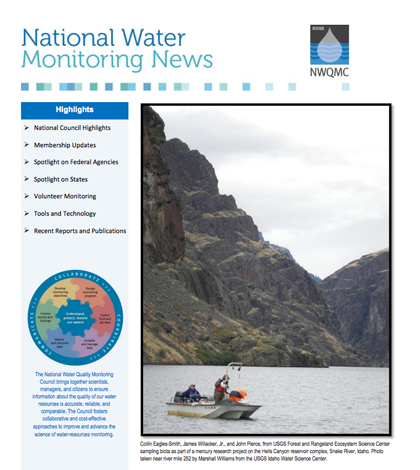New NWQMC newsletter updates on EPA national surveys, volunteer monitoring study

A new edition of “National Water Monitoring News,” the newsletter of the National Water Quality Monitoring Council, is now available (PDF).
This issue has updates on the Environmental Protection Agency’s National Aquatic Resource Surveys, a set of surveys that take a standardized look at rivers, lakes, coasts and wetlands across the country. Last year, we covered the release of draft of the National Rivers and Streams Assessment 2008-2009, which showed that biological quality in more than half of rivers assessed was in “poor condition.” From our report:
About 55 percent of streams have poor conditions for biology based on surveys of benthic macroinvertebrates and algae. Another 21 percent are in good condition.
Macroinvertebrate species loss was also covered in the study. About 17 percent of streams lacked more than 50 percent of their expected species, compared with reference sites. However, almost 40 percent of streams retained more than 90 percent of their wildlife.Still, the damage to wildlife is significant, said Ellen Tarquinio, EPA environmental protection specialist and one of the study’s main coordinators. “There’s a large portion of our stream miles that have lost a significant percent of their taxa,” she said.
The assessment also showed 40 percent of the nation’s rivers have too much phosphorous, a 19 percent increase from a 2004 study of wadeable streams.
The news wasn’t all bad: Nitrogen impairments were in decline and fish habitat conditions improved compared to the 2004 study.
According to the update in the new National Water Monitoring News, the final version of that draft report has been delayed, while the sampling is almost complete for the next rivers and streams assessment covering 2013 and 2014. Meanwhile, the National Coastal Condition Assessment, the first of its kind under the program, is due to have a draft report released next summer.
There’s plenty more going on in the newsletter, but the last thing I wanted to mention is a summary of a study on the management and policy impacts of volunteer water quality monitoring programs. The study, from Wisconsin Water Action Volunteers Stream Monitoring Program director Kris Stepenuck, found that “programs that coalesce around and focus on addressing an environmental crisis, those that have state and/or EPA-approved quality assurance project plans, and those with larger budgets had more policy and management successes than others.”





0 comments